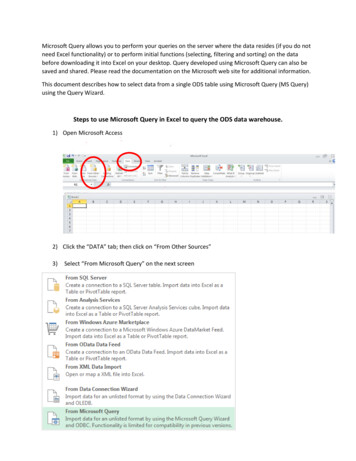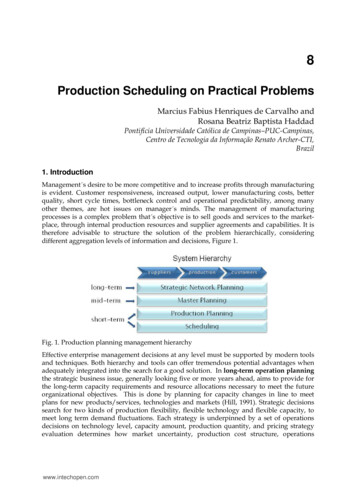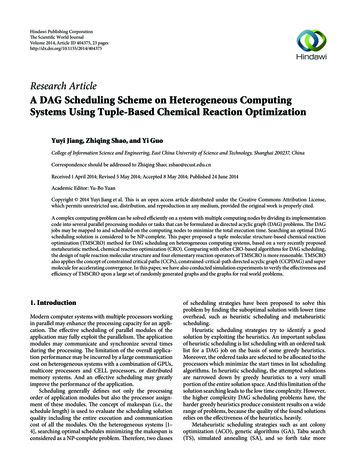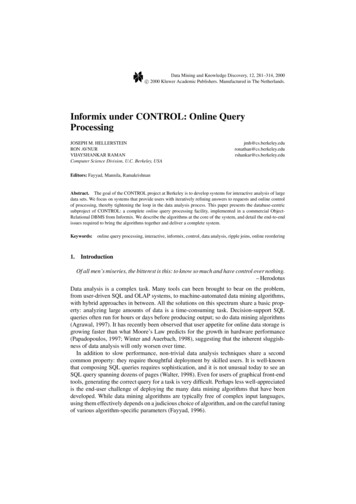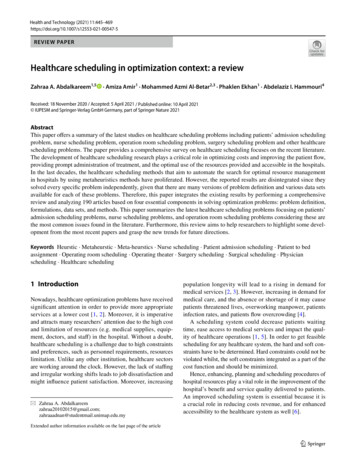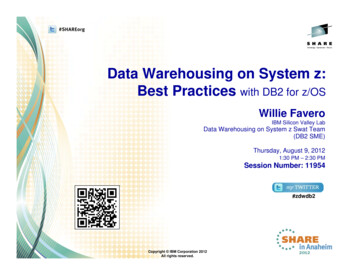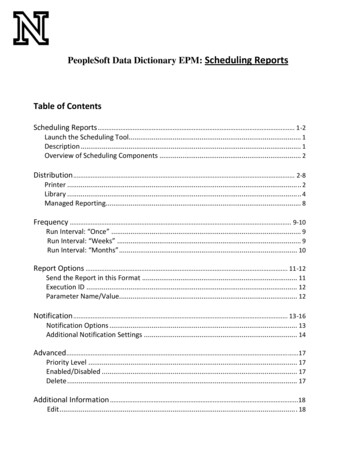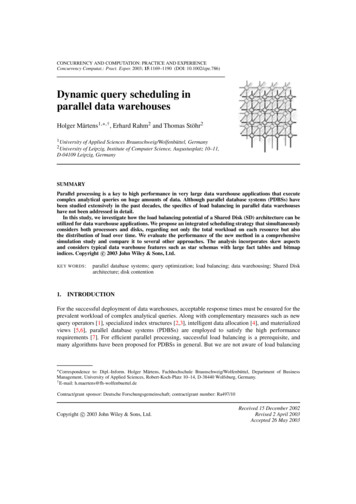
Transcription
CONCURRENCY AND COMPUTATION: PRACTICE AND EXPERIENCEConcurrency Computat.: Pract. Exper. 2003; 15:1169–1190 (DOI: 10.1002/cpe.786)Dynamic query scheduling inparallel data warehousesHolger Märtens1, ,† , Erhard Rahm2 and Thomas Stöhr21 University of Applied Sciences Braunschweig/Wolfenbüttel, Germany2 University of Leipzig, Institute of Computer Science, Augustusplatz 10–11,D-04109 Leipzig, GermanySUMMARYParallel processing is a key to high performance in very large data warehouse applications that executecomplex analytical queries on huge amounts of data. Although parallel database systems (PDBSs) havebeen studied extensively in the past decades, the specifics of load balancing in parallel data warehouseshave not been addressed in detail.In this study, we investigate how the load balancing potential of a Shared Disk (SD) architecture can beutilized for data warehouse applications. We propose an integrated scheduling strategy that simultaneouslyconsiders both processors and disks, regarding not only the total workload on each resource but alsothe distribution of load over time. We evaluate the performance of the new method in a comprehensivesimulation study and compare it to several other approaches. The analysis incorporates skew aspectsand considers typical data warehouse features such as star schemas with large fact tables and bitmapc 2003 John Wiley & Sons, Ltd.indices. Copyright KEY WORDS :parallel database systems; query optimization; load balancing; data warehousing; Shared Diskarchitecture; disk contention1. INTRODUCTIONFor the successful deployment of data warehouses, acceptable response times must be ensured for theprevalent workload of complex analytical queries. Along with complementary measures such as newquery operators [1], specialized index structures [2,3], intelligent data allocation [4], and materializedviews [5,6], parallel database systems (PDBSs) are employed to satisfy the high performancerequirements [7]. For efficient parallel processing, successful load balancing is a prerequisite, andmany algorithms have been proposed for PDBSs in general. But we are not aware of load balancing Correspondence to: Dipl.-Inform. Holger Märtens, Fachhochschule Braunschweig/Wolfenbüttel, Department of BusinessManagement, University of Applied Sciences, Robert-Koch-Platz 10–14, D-38440 Wolfsburg, Germany.† E-mail: h.maertens@fh-wolfenbuettel.deContract/grant sponsor: Deutsche Forschungsgemeinschaft; contract/grant number: Ra497/10c 2003 John Wiley & Sons, Ltd.Copyright Received 15 December 2002Revised 2 April 2003Accepted 26 May 2003
1170H. MÄRTENS, E. RAHM AND T. STÖHRstudies for data warehouse environments which exhibit characteristic features such as star schemas,star queries and bitmap indices.This paper presents a novel approach to dynamic load balancing in parallel data warehouses based onthe simultaneous consideration of multiple resources, specifically CPUs and disks. These are frequentbottlenecks in the voluminous scan/aggregation queries that are characteristic of data warehouses.Disk scheduling is particularly important here as the performance of CPUs develops much faster thanthat of disks. A balanced utilization of both resources depends not only on the location (on which CPU)but also on the timing of load units such as subqueries. We thus propose performing both decisions inan integrated manner based on the resource requirements of queued subqueries as well as the currentsystem state.To this end, we exploit the flexibility of the Shared Disk (SD) architecture [8] in which eachprocessing node can execute any subquery. For scan workloads in particular, the distribution ofprocessor load does not depend on the data allocation, allowing us to perform query scheduling withshared job queues accessed by all nodes. Disk contention, however, is harder to control than CPUcontention because the total amount of load per disk is predetermined by the data allocation and cannotbe shifted at runtime as for processors.In a detailed simulation study, we compare the new integrated strategy to several simpler methodsfor dynamic query scheduling. They are evaluated for a data warehouse application based on theAPB-1 benchmark comprising a star schema with a huge fact table supported by bitmap indices,both declustered across many disks to support parallel processing. Our experiments involve largescan/aggregation queries in which each fact table fragment must often be processed together with anumber of associated bitmap fragments residing on different disk devices. This can lead to increaseddisk contention and thus creates a challenging scheduling problem. We particularly consider thetreatment of skew effects which are critical for performance but have been neglected in most previousload balancing studies. As a first step in the field of dynamic load balancing for data warehouses,our performance study focuses on parallel processing of large queries in single-user mode, but thescheduling approaches can also be applied in multi-user mode.Our paper is structured as follows. In Section 2, we review some related work from the literature.Section 3 outlines our general load balancing paradigm, whereas our specific scheduling heuristics aredefined in Section 4. Section 5 describes the simulation system and the approaches to deal with skew.Section 6 presents the performance evaluation of the scheduling strategies for different data warehouseconfigurations. We conclude in Section 7.2. RELATED WORKWe are not aware of any load balancing studies for parallel data warehouses. For general PDBSs, loadbalancing problems have been widely researched, for a variety of workloads and architectures [9–14].Many of these approaches are of minor relevance for data warehousing because they rely on a costlyredistribution of data—e.g. for hash joins or external sorting—that is usually too costly for a largefact table. Furthermore, most previous studies have been limited to balancing CPU load, sometimesincluding main memory [15,16] or network restrictions [17]. Even so, the need for highly dynamicscheduling has been emphasized [16, 18–20]. Conversely, load distribution on disks has largely beenconsidered in isolation from CPU-side processing. Most of these studies have focused either on datac 2003 John Wiley & Sons, Ltd.Copyright Concurrency Computat.: Pract. Exper. 2003; 15:1169–1190
DYNAMIC QUERY SCHEDULING IN PARALLEL DATA WAREHOUSES1171partitioning and allocation [13, 21–26] or on limiting disk contention through reduced parallelism [14].Integrated load balancing of processors and disks considering the timing of potentially conflictingoperations—as proposed in this paper—has not been addressed.The SD architecture has been advocated due to its superior load balancing potential [11,14,27,28]especially for read-only workloads as in data warehouses, where common objections regarding theperformance of concurrency and coherency control [29,30] can be ruled out. It also offers greaterfreedom in data allocation, e.g. for index structures [24]. But the research on how to exploit thispotential is still incomplete. SD is also supported by several commercial PDBSs such as IBM DB2Universal Database for OS/390 and z/OS [31], Oracle9i Database [32], and Sybase Adaptive ServerIQ Multiplex [33]. Like other products addressing the data warehouse market—e.g. IBM InformixExtended Parallel Server [34], IBM Red Brick Warehouse [35], Microsoft SQL Server 2000 [36]and NCR Teradata [37]—they support star schemas and bitmap indices‡ as well as adequate datafragmentation and parallel processing. However, the vendors do not describe specific schedulingmethods in the available documentation. Dynamic treatment of disk contention is limited to restrictingthe number of tasks concurrently reading from the same disk, similar to the Partition strategy used inour study (cf. Section 4.1). No special ordering of subqueries to avoid disk contention is mentioned,leading us to believe that such elaborate scheduling methods are not yet supported in current products.3. DYNAMIC LOAD BALANCING FOR PARALLEL SCAN PROCESSINGThis section presents our basic approach to dynamic load balancing, which is not restricted todata warehouse environments. We presume a horizontal partitioning of relational tables into disjointfragments. If bitmap indices or similar access structures exist, they must be partitioned analogouslyso that each table fragment with its corresponding bitmap fragments can form an independent unitof processing. We focus on the optimization of scan queries and exploit the flexibility of the SDarchitecture that allows every processor to access any fragment regardless of its storage location.For efficient parallel processing, database workloads must be distributed across the system as evenlyas possible. For the extensive scan loads we consider in our study, this is true even within singlequeries (intra-query parallelism). As mentioned in the introduction, the two performance-critical typesof resources are the processing nodes and the disks. (Main memory and network connections are nottypically bottlenecks for the scan operations in question.) But the balance of CPU and disk load,respectively, depends on different conditions: CPU utilization is largely determined by which processoris assigned which fragments of the data. A balanced disk load, however, hinges on when the dataresiding on each device are processed because their location cannot be changed at runtime. As aconsequence, we aim for a load balancing strategy that can view both resources in an integrated manner.When a new query enters the system, it is randomly assigned a coordinator node that controls itsexecution and distributes the workload in the system. For the scan queries we consider, we provide twodifferent load granules based on the aforementioned horizontal fragmentation of tables: each subquerycan comprise either a fragment or a partition of the relevant table, where a partition is defined as the‡ In SQL Server and Teradata, bitmap indices are used internally but cannot be defined by the user or DBA.c 2003 John Wiley & Sons, Ltd.Copyright Concurrency Computat.: Pract. Exper. 2003; 15:1169–1190
1172H. MÄRTENS, E. RAHM AND T. mentresultingload unitpartitionpartitionwise fragmentwisescheduling schedulingFigure 1. Partitionwise versus fragmentwise processing. Fragments provide a better load balance but require alarger number of subqueries (more arrows) and also incur disk contention.union of all table fragments residing on the same disk (Figure 1). If the table is logically fragmentedand its fragmentation attributes are also referenced in the query’s selection predicate, some fragmentsmay be excluded from processing because they are known to contain no hit rows. Subqueries willbe generated only for relevant fragments or partitions, respectively. With either granule, we obtainindependent subqueries that are uniform in structure and can be processed isolated from each otherin arbitrary order, each on any one processing node. This gives us great flexibility in the subsequentscheduling step.As fragments are much smaller than partitions, they permit a more even load distribution, especiallyin case of skew (Figure 1). Larger granules like partitions, however, require less communicationbetween the coordinator and the other processing nodes and also reduce the overhead of schedulingitself. Furthermore, they minimize inter-subquery contention on the disks as no two nodes will processthe same table partition, although subqueries may still interfere with each other when accessing bitmapindices (if present).3.1. SchedulingPresuming the voluminous queries we examine to work in full parallelism on all available processingnodes, we are left with the task of allocating subqueries to processors and timing their execution.We consider this scheduling step particularly important as it finalizes the actual load distribution in thesystem.Based on the load granule, the query coordinator maintains a list of subqueries that are assignedto processors following the given ordering policy and processed locally as described below.c 2003 John Wiley & Sons, Ltd.Copyright Concurrency Computat.: Pract. Exper. 2003; 15:1169–1190
DYNAMIC QUERY SCHEDULING IN PARALLEL DATA WAREHOUSES1173Each processor may obtain several subqueries up to a given limit t, and processing nodes are addressedin a round-robin manner, providing an equal number of subqueries per node ( 1). If there are moresubqueries than can be assigned to the nodes, as is usually the case for larger queries, the remainderare kept in a central queue. When a processor finishes a subquery and reports the local result tothe coordinator, it is assigned new work from the queue until all subqueries are done. Finally, thecoordinator returns the overall query result to the user.This simple, highly dynamic approach already provides a good balance of processor load. A nodethat has been assigned a long-running subquery will automatically obtain less load as executionprogresses, thus nearly equalizing CPU load. Since no two subqueries address the same fragment,we may also achieve low disk contention by having different processors work on disjoint subsets ofdata. Specifically, tasks intensely addressing the same disk(s) should not be executed at the same time;consequently, they should be kept apart in the subquery queue. The specific ordering heuristics used inour study are detailed in Section 4.3.2. Local processing of subqueriesWhen a node is assigned a fragment-sized subquery, it processes any required bitmap fragments andthe respective table fragment simultaneously, minimizing memory consumption. Prefetching is used toread multiple pages into the buffer with each disk I/O. Furthermore, parallel I/O is employed for bitmappages read from different disks. For the scan/aggregation queries we assume, the measures containedin the selected tuples are aggregated locally to avoid a shipping of large datasets, and the partial resultsare returned to the coordinator node at subquery termination. For partition-sized load granules, a nodewill process sequentially (i.e. in logical order) all the relevant fragments within its partition, simplyskipping the irrelevant ones. Aggregates will be returned only for the entire partition to minimizecommunication costs. Multiple subqueries on the same processor coexist without any need for intranode coordination. The maximum number of concurrent tasks per node, t, should correspond roughlyto the performance ratio of CPUs to disks to achieve a good resource utilization (cf. Section 6.1).4. SCHEDULING ORDER OF QUERY EXECUTIONAs mentioned in the previous section, we regard the scheduling of subquery execution as the mostimportant aspect of load balancing in our processing model as it determines the actual load distributionfor both processors and disks. Based on the general scheme outlined above, the following subsectionspresent scheduling policies based on either static (Section 4.1) or dynamic (Section 4.2) ordering ofsubqueries. Section 4.3 summarizes the final strategies compared in our simulation study.4.1. Statically ordered schedulingOur simpler heuristics employ a static ordering of subqueries. Note that even under these strategies,our scheduling scheme as such is still dynamic since the allocation of load units to processing nodes isdetermined at runtime based on the progress of execution.c 2003 John Wiley & Sons, Ltd.Copyright Concurrency Computat.: Pract. Exper. 2003; 15:1169–1190
1174H. MÄRTENS, E. RAHM AND T. STÖHR4.1.1. By partition numberSubqueries are dispatched in a round-robin fashion with respect to the relevant table partitions, whereeach partition corresponds to one disk as defined in Section 3. Ideally, this means that no more than onesubquery should work on a partition at any given time, unless there are more concurrent subqueries thanpartitions. In practice, subqueries do not necessarily finish in the same order in which they are started,so that disk load may still become skewed over time with fragment-sized load units. For partitionwisescheduling, of course, each table partition is guaranteed to be accessed by only one processor. Withboth granules, bitmap access (if required) can cause each subquery to read from multiple disks, so thata certain degree of access conflict may be inevitable. Still, we expect this strategy to achieve very lowdisk contention in all cases.4.1.2. By fragment numberThis heuristic applies only to fragment-sized load granules. It assigns subqueries in the logical orderof the fragments they refer to. In the default case with a round-robin allocation of fragments to disks(cf. Section 5.3), this is equivalent to scheduling by partition number as long as a query referencesa consecutive set of fragments. Otherwise, the two will be similar but not identical. For differentallocation schemes, the correlation of fragment numbers to partition numbers may be lost completely.This strategy was used in [4] and is included here as a baseline reference.4.1.3. By sizeThis policy starts the largest subqueries first, using the expected number of referenced disk pages asa measure. (See Section 4.2 for its calculation.) It implements an LPT (longest processing time first)scheme that has been proven to provide good load balancing for many scheduling problems [38]. It doesnot consider disk allocation in any way but may be expected to optimize the balance of processor loadwhich primarily depends on the total amount of data processed per node.4.2. Dynamically ordered schedulingThe static ordering policies described so far tend to optimize the balance of either CPU or disk load.Implementing an integrated load balancing requires a more elaborate, dynamic ordering that reckonswith both criteria: in order to distribute disk load over time and reduce contention, we estimate forevery subquery its expected access volume on each disk and then try to execute concurrently thosetasks that have minimum overlap in disk access. To simultaneously balance CPU load, we additionallyconsider the sizes of subqueries similar to the previous section.4.2.1. Disk access conflictsBefore we can present our integrated scheduling method, we have to detail the calculation of diskaccess conflicts it incorporates. For simplicity of presentation, we will assume a load granule of singlefragments, but all further considerations equally apply to partition-sized subqueries. Similarly, we willc 2003 John Wiley & Sons, Ltd.Copyright Concurrency Computat.: Pract. Exper. 2003; 15:1169–1190
DYNAMIC QUERY SCHEDULING IN PARALLEL DATA WAREHOUSES1175refer to tables with supporting bitmap indices as used in our data warehouse application, although allconcepts can be easily transferred to other data structures.One way to consider the current disk utilization is to constantly measure the actual load of alldisks and periodically propagate it to the coordinator node. These statistics may be quickly outdatedespecially if the update interval is higher than the execution time of individual subqueries. To avoidthese problems, we construct our own image of disk utilization based on estimated access profiles ofsingle subqueries, the sum of which can be updated instantaneously in every scheduling step. First, wemodel the expected number of pages referenced per disk for each given subquery. For the relevant tablefragment, this number is calculated from the subquery’s estimated selectivity using an approximationof Yao’s formula [39,40]. We further take into account the associated bitmap fragments as far as theyare required for the query. The result is a load vectors)ps (p1s , p2s , . . . , pDwhere pds denotes the expected number of pages accessed on disk d by subquery s § . But sincethe degree of contention between subqueries at a given point in time does not depend on theirtotal sizes, we are more interested in the distribution of load across the disks than in its absolutemagnitude. Assuming that the execution time of s is approximately proportional to the total amountof data processed, we normalize the load vectors based on the total size of a subquery that computesstraightforward asD p̂s pdsd 1(This value is also used for the scheduling-by-size heuristic above.) We divide each subquery’s loadvector by p̂s to obtain its intensity vectors)i s (i1s , i2s , . . . , iDwhich is now normalized to a total of 1, so that each coefficient ids denotes the percentage of its loadthat subquery s puts on disk d.We now define similar coefficients for a set of subqueries executed concurrently. The intensity vectorof a subquery set S is given by the itemwise sum of the single vectors, re-normalized to 1 by divisionwith the number of subqueries, S : i s / S with IdS tds / S IS s Ss SAnalogous to single subqueries, it once again denotes the percentagewise load distribution across alldisks, but this time for the entire subquery set. Note that we added the intensity vectors rather thanthe original load vectors of the subqueries because we are interested in the current load distribution(per time unit), so we would not want to weight subqueries by their sheer sizes at this point.§ For our star schema application, p s will typically contain one large value representing the fact table fragment and severalsmaller ones for the required bitmap fragments; the remaining items will be 0.c 2003 John Wiley & Sons, Ltd.Copyright Concurrency Computat.: Pract. Exper. 2003; 15:1169–1190
H. MÄRTENS, E. RAHM AND T. STÖHRintensity vectors iload vector pr1to ir3normalizationnormalizationload vector pr1load vector prunning subqueries1176r2r3total intensity vector iRq1q2intensity vector iq3Cq 1 RCq 2 RCq 3 Rtotalper diskintensity vector iconflictintensity vector iqueued subqueriesmultiply intensitiesFigure 2. Example of conflict calculation. Three queued subqueries (q1 , q2 , q3 ) are evaluated forconcurrent execution with three running subqueries (r1 , r2 , r3 ); q1 has the lowest rate of conflict andis selected. The shape of the load vectors is typical of our application (one peak for a large tablefragment, plus several small bitmap fragments).Finally, we can define the disk access conflict between a single subquery s (to be scheduled) and aset of subqueries S (to be processed concurrently) asC s,S D cds,Swithcds,S ids · IdSd 1This means that we first calculate the conflict of s and S per disk by multiplying their intensitieslocally, then add the results to obtain the total conflict rate. This total will have a value between zero(no conflict, i.e. s and S use disjoint disks) and one (maximum conflict, if s and S use the same singledisk). The calculation of conflicts between concurrent subqueries is illustrated in Figure 2 using afive-disk example; each table fragment is assumed to have three associated bitmap fragments.4.2.2. Integrated schedulingBased on this notation, we can now identify in every scheduling step the subqueries that show minimumconflict with the set of subqueries currently running, R, enabling us to balance disk load over thec 2003 John Wiley & Sons, Ltd.Copyright Concurrency Computat.: Pract. Exper. 2003; 15:1169–1190
DYNAMIC QUERY SCHEDULING IN PARALLEL DATA WAREHOUSES1177Table I. Scheduling strategies used in simulation experiments.NotationLoad tionfragmentfragmentfragmentstatic, by partition numberstatic, by fragment numberstatic, by sizedynamic, by conflict and sizeduration of the query. To simultaneously address the distribution of CPU load, we also consider thesize of a subquery as in the static ordering by size from the previous section. Specifically, we wantlong-running subqueries to have priority over—i.e. to be executed earlier than—shorter ones even ifthey incur a somewhat higher degree of disk contention. With Q denoting the set of queued subqueries,the final resulting policy can be phrased as‘select q Q so that C q,R /p̂q is minimized’.Since the intensity vector for the current disk load, I R , will change with every subquery starting orfinishing execution, it is now clear that the order of subqueries must indeed be determined dynamically.In Figure 2, subquery q1 has minimal conflict with the subqueries already running, mainly because thetable fragment it uses is on a different disk than those accessed by r1 through r3 . It will thus be executednext unless it is significantly smaller than q2 and q3 .4.2.3. VariantsNumerous extensions to this strategy were evaluated in our study, but are omitted here for lack of space.These include the consideration of conflicts with other queued subqueries (to reduce contention in thefuture), different weightings of conflict against size (including the conflict criterion alone), as well asa second normalization of load vectors to compensate for a skewed overall load for the entire query.4.3. Proposed strategiesLoad granules and scheduling policies may, in principle, be combined arbitrarily, with the exceptionthat partitionwise scheduling cannot sensibly be based on fragment numbers, as each partition containsseveral fragments. In the remainder of this paper, we will consider the four scheduling strategies listedin Table I with the indicated notations. We have, in fact, experimented on many more strategies, butwill report in detail only on the more relevant ones.5. SIMULATION SYSTEM AND SETUPOur proposed strategies were implemented in a comprehensive simulation system for parallel datawarehouses that has been used successfully in previous studies [4], extended with the query processingc 2003 John Wiley & Sons, Ltd.Copyright Concurrency Computat.: Pract. Exper. 2003; 15:1169–1190
1178H. MÄRTENS, E. RAHM AND T. STÖHRTable II. System parameters used in simulations.ParameterProcessing nodestotal number (P )Valuegeneralspeed-upCPU speedsubqueries per node (t)202–50100 MIPSvariedParameterBuffer managerpage sizebuffer sizeValuefact tablebitmapsotherprefetch sizeNo. of instructionsper queryper subqueryper I/Oper bitmap pageper table rowper eread overhead per ive100 00010 00010 00010 0001500400500020 0001001001000 # bytes1000 # bytesDisk devicestotal number (D)average seek timeaverage settle time controller delayNetworkconnection speedmessage sizegeneralspeed-upper access per pagesmalllarge8 KB5000 pages5000 pages5000 pages8 pages10020–1008 ms4 ms0.5 ms100 Mbit/s128 B1 page (8 KB)methods detailed above. The following subsections describe the architecture and parameters of thesimulated DBMS (Section 5.1), our sample database schema (Section 5.2), the modeling and treatmentof skew effects (Section 5.3), and the query workload used in our subsequent experiments (Section 5.4).5.1. System architecture and parametersFor this study, we simulate a generic SD PDBS and use the parameters given in Table II. The systemrealistically reflects resource contention by modeling CPUs and disks as servers. CPU overhead isreckoned for (sub-)query start-up, planning and termination; I/O initiation; page access; scanning ofbitmaps; extraction and aggregation of fact rows; as well as communication overhead. Seek times in thedisk modules depend on the location (track number) of the desired data within a disk. Each processorhas an associated buffer module maintaining separate LRU queues for different page types (fact table,bitmap indices, permanent allocation). The network incurs communication delays proportional tomessage sizes but models no contention, so as to avoid specific network topologies unduly influencingexperimental results.5.2. Sample database schema and fragmentationThe data warehouse scenario in which we evaluate our load balancing methods models a relationalstar schema for a sales analysis environment (Figure 3) that was derived from the specification ofthe Application Processing Benchmark (APB-1) [41]. The denormalized dimension tables Product,Customer, Channel and Time each define a hierarchy (such as product divisions, lines, families,c 2003 John Wiley & Sons, Ltd.Copyright Concurrency Computat.: Pract. Exper. 2003; 15:1169–1190
DYNAMIC QUERY SCHEDULING IN PARALLEL DATA HANNEL 2.4 billion ermonth2824Figure 3. Sample star schema.and so on). The fact table Sales comprises several measure attributes (turnover, cost etc.) and aforeign key to each dimension. With a density factor of 1%, it contains a tuple for 1/100 of all valuecombinations. A typical two-dimensional star query on this schema might, for instance, aggregate theturnover of a retailer over a single month (denoted by QRetailerMonth) which can be expressed in SQL asSELECT SUM(DollarSales)FROM Sales S, Customer CWHERE C.Retailer RETAILERAND S.RefTime MONTHAND C.RefCustomer C.StoreWe incorporate common bitmap join indices [2] to avoid costly full scans of the fact table. We employstandard bitmaps for the low-cardinality dimensions Time and Channel, but use hierarchically encodedbitmaps [42] for the more voluminous dimensions Product and Customer to save disk space and I/O.With these indices, queries like the above can avoid explicit join processing between fact table anddimension table(s) in favor of a simple selection using the respective precomputed bitmap(s).We follow a horizontal, multi-dimensional and hierarchical fragmentation strategy for star schemas(MDHF) that we proposed and evaluated in [4]. Specifically, we choose a two-dimensionalfragmentation based on Time.Month and Product.Family. Each resulting fact table fragment combinesall rows referring to one particular product family within one particular month, creating n 375 24 9000 fragments, according to
Parallel processing is a key to high performance in very large data warehouse applications that execute complex analytical queries on huge amounts of data. Although parallel database systems (PDBSs) have been studied extensively in the past decades, the specifics of load balancing in parallel data warehouses have not been addressed in detail.

